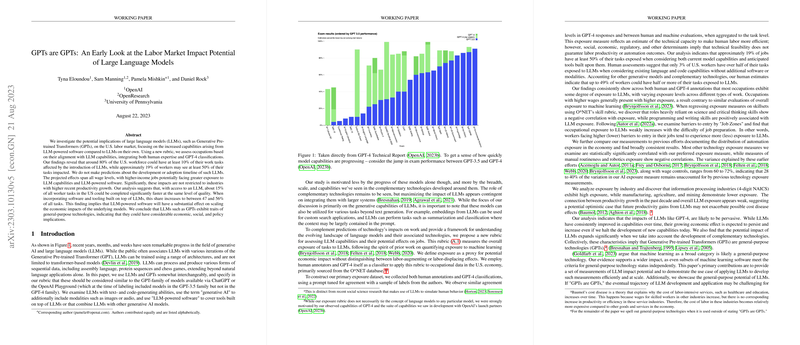An Overview of the Labor Market Impact Potential of LLMs
The paper "GPTs are GPTs: An Early Look at the Labor Market Impact Potential of LLMs" by Eloundou, Manning, Mishkin, and Rock provides a rigorous examination of the potential effects of LLMs, like Generative Pre-trained Transformers (GPTs), on the U.S. labor market. The paper evaluates how LLM capabilities might influence occupations across various wage levels, using GPT-4 as a case paper for these models' implications.
Methodology and Key Findings
By integrating a newly developed rubric with both human expertise and GPT-4 classifications, the authors assess the proportion of tasks within occupations that are exposed to automation through LLMs. The paper reveals that approximately 80% of the U.S. workforce could experience a significant impact—at least 10% of their work tasks affected by the introduction of LLMs. Remarkably, about 19% of workers might see over 50% of their tasks exposed to potential automation.
The authors measure these impacts using three primary metrics:
- Direct Exposure (): Tasks that GPTs can complete independently, reducing task time by at least 50%.
- LLM+ Exposure (): Tasks that can be significantly accelerated by LLMs when used together with complementary software.
- Broader LLM+ Exposure (): An upper bound considering additional capabilities such as image generation.
The numerical results underscore that LLMs primarily affect higher-income occupations more profoundly than lower-income jobs. This divergence from conventional wisdom—that automation predominantly influences lower-wage, routine-based roles—challenges existing perspectives on labor market disruptions due to technology. Additionally, the paper notes that the benefits of LLM-powered software significantly exceed the impact of LLMs alone, highlighting the transformative potential of integrated technological ecosystems.
Occupational and Wage Analysis
The researchers’ findings affirm that both direct exposure to LLM capabilities and the extended possibilities through LLM-powered applications have critical implications. Higher-wage occupations such as those in STEM fields, legal professions, and technical writing showed elevated exposure levels. In contrast, occupations requiring less formal education exhibit lower exposure scores. This distribution emphasizes that technological advancements are pervading not only traditional automation-prone industries but also vocations that rely heavily on cognitive and professional skills.
The statistical analysis further reveals a correlation between skill sets and exposure levels. For instance, programming and writing skills positively correlate with higher exposure, whereas science and critical thinking skills show a negative association. Moreover, barriers to entry—measured by educational and training requirements—demonstrate that occupations in higher "Job Zones" (demanding extensive preparation) generally face increased exposure from LLMs.
Validation and Comparison with Prior Research
The paper does not operate in isolation; it validates its findings by comparing them with previous research on automation and AI exposure. Notably, it aligns with studies that quantified exposure to machine learning and automation technologies. The paper's novel contribution is its focused analysis on LLMs, highlighting that these models alone have unique effects distinct from broader AI categories.
The comparison with earlier frameworks like those by Brynjolfsson et al. (2018) and Frey and Osborne (2017) finds consistent correlations, though it distinguishes LLMs' unique capability to handle complex cognitive tasks that could not previously be automated.
Policy Implications and Future Directions
The paper suggests significant implications for economic policy and workforce planning. If LLMs are indeed general-purpose technologies (GPTs), their pervasive and evolving impacts necessitate proactive measures. These could include adapting educational curricula to emphasize skills less prone to automation, workforce retraining programs, and a regulatory framework considerate of emerging technologies.
However, the path forward is replete with uncertainties. Despite the robust analysis, the future development trajectory of LLMs and the speed of their adoption remain critical unknowns. Consequently, the paper proposes ongoing research into the real-world performance and integration of LLMs, further examination of industries and job functions, and monitoring the evolving capabilities of these models.
Conclusion
Eloundou et al. provide a comprehensive and nuanced examination of the labor market impact potential of LLMs. The findings underscore that LLMs, including models beyond transformer-based architectures, exhibit characteristics of general-purpose technologies. Their capabilities stand to alter job tasks significantly across many professions, suggesting urgent considerations for workforce adaptability, policy framing, and future technological integration. This empirical analysis offers a foundational understanding for ongoing discussions on how society can navigate the transformative period ushered in by advancements in natural language processing.
